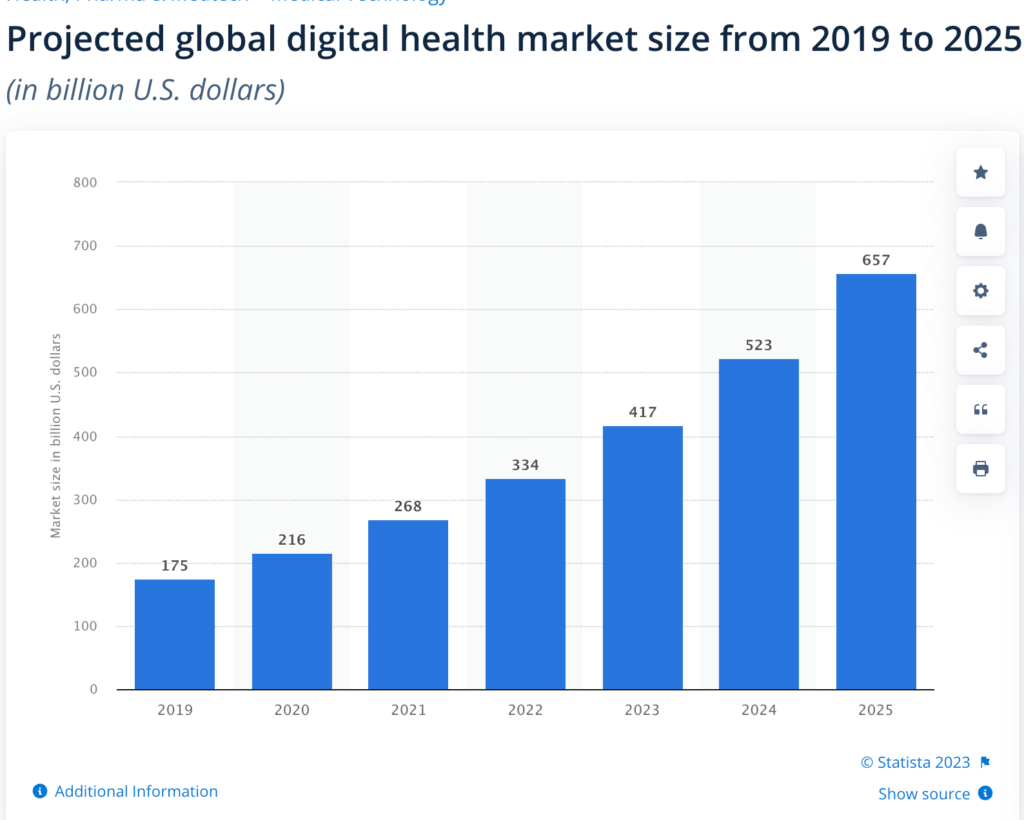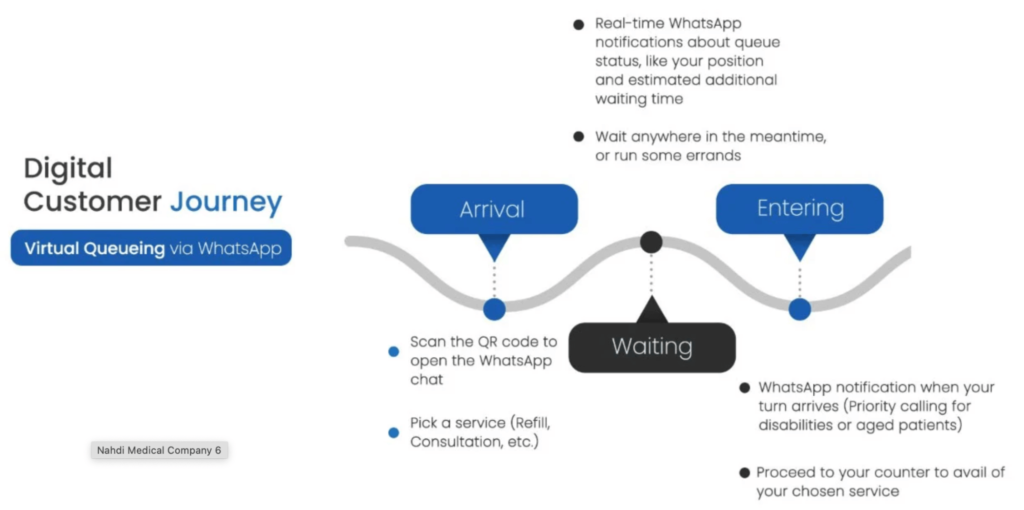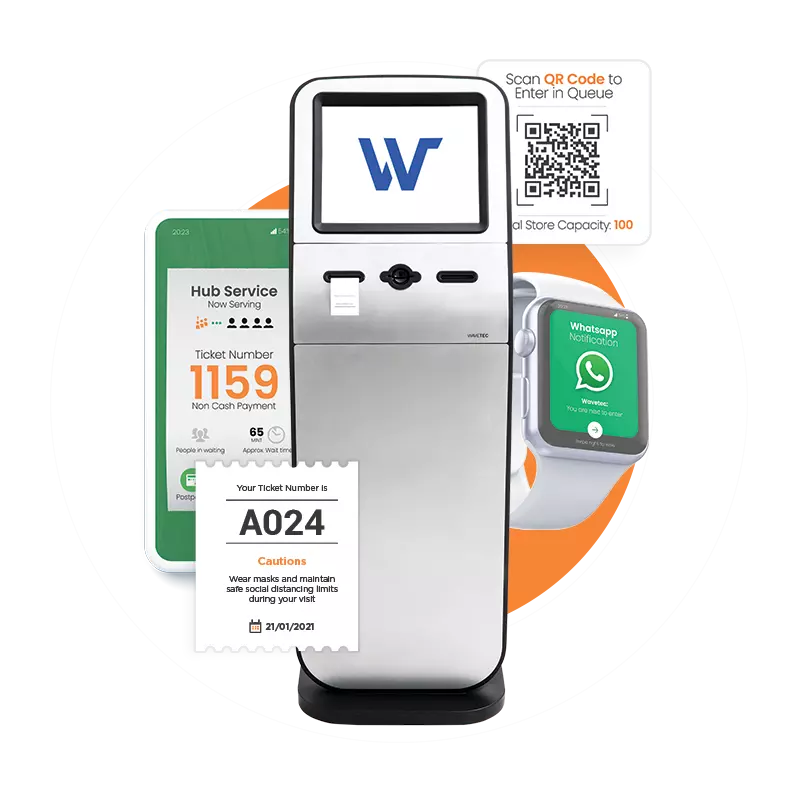Are you ready to embrace new technologies that will maximize the potential of your healthcare data and help you achieve your business goals?
Since the COVID-19 pandemic, the healthcare industry has seen a shift in trends to include a more digital approach. Over the years, investor funding in digital transformation in the healthcare industry has increased significantly. In 2020, telemedicine was the highest-funded healthcare category, followed by data analytics and health applications.
Healthcare solutions such as online appointment booking and patient portals have provided more convenient and accessible care. This has helped healthcare facilities reach targetted KPIs of reducing administrative burdens, wait times, and appointment cancellation rates.
A study by Deloitte concluded that 92% of healthcare professionals saw improved performances with digital transformation.
In this blog, we will explore the benefits and use cases of digital healthcare solutions, including telemedicine, patient portals, and in-hospital monitoring.
Before adopting any of the services, you should understand the challenges associated with digital transformation in healthcare.
Keep reading to find out more!
What is Digital Transformation in Healthcare?
Digital transformation in the healthcare industry refers to integrating technology into all aspects of healthcare provision. This, in turn, has a positive effect on patient experience. It facilitates and streamlines hospital operations and enhances patient care. Digital innovation in healthcare is an investment to revolutionize healthcare systems, reduce costs, and make healthcare affordable.
Healthcare and digital transformation are based on integrating various technologies to create a seamless workflow. These include using electronic health records, telemedicine, health information exchanges, artificial intelligence, health applications, and wearable devices. Such digital tools have improved the efficiency, quality, and accessibility of healthcare services.
Since the COVID-19 pandemic, digital healthcare transformation has accelerated. The Centers for Disease Control and Prevention reported that telemedicine increased by 154% in March 2020.
Statista has identified digital health tools as the future of the healthcare industry, with a market growth projection of $660 billion in 2025. Another study by Global Market Insights, Inc. concludes that the global digital health market is expected to grow at a CAGR of 17.4% to reach $426.9 billion in 2027. A survey by the Deloitte Center for Health Solutions in 2021 concluded that 88% of organizations invested in patient care and engagement.

Digital transformation in healthcare carries immense importance in individuals as they expect human-centric models. According to a recent survey by Deloitte Inc., more than 40% of patients expressed a desire to continue using telehealth post-pandemic. Another survey concluded that 92% of the respondents expected better patient outcomes from digitizing healthcare.
Given the benefits of healthcare digitalization, let’s explore the concept and the challenges faced in adopting digital transformation in healthcare.
How Digital Transformation Improve in Healthcare
Here are the 6 biggest use cases of digital healthcare solutions:
- on-demand healthcare solutions
- online appointment booking
- Virtual Queue Management
- Patient Portals
- Telemedicine
- In-hospital patient monitoring
1. On-demand healthcare solutions
Patients look for convenience and ease of accessibility to receive healthcare services without visiting a healthcare facility. Individuals can use mobile devices or computers for services such as telemedicine, mobile health applications, accessing medical records, and virtual consultations.
On-demand healthcare solutions benefit patients far from healthcare facilities. Patients can receive remote consultations, diagnosis, and treatment from the comfort of their own homes. This reduces healthcare disparities and ensures all patients have access to healthcare facilities.
2. Online Appointment Booking

Online appointment booking can provide patients with a more convenient and streamlined way to schedule appointments from anywhere. This tool is helpful in patient adherence as it sends patients automated reminders via email or text message.
It automates the follow-up appointment booking process for healthcare providers and reduces manual data entry. It provides comprehensive patient data, including demographics, medical history, and appointment history. This can help healthcare providers better understand their patient’s needs and provide more personalized care. This can reduce administrative costs and improve staff productivity.
Wavetec has introduced SafeQ, an online appointment scheduling service. This allows patients to check in, reschedule and cancel appointments virtually.
3. Virtual Queue Management

A virtual queue system helps maintain social distancing by reducing the number of patients in waiting rooms. Patients can wait for their appointments from anywhere, anytime, without waiting in a crowded waiting room. You can reallocate resources and yield profits for your business.
Nahdi Medical Company is among the healthcare pioneers to adopt and facilitate virtual and contactless queueing for their customers, using Wavetec’s WhatsApp Queueing solution. Patients scan the QR code to open WhatsApp chat, choose the desired service, and receive wait notifications until it is their turn.
During the pandemic, AlMoosa COVID-19 Vaccination Centre installed Wavetec’s Queue Management package, which included a ticket dispenser, LED display for digital signage, and Spectra Reporting and Dashboards. This reduced crowds, presented contactless solutions, and optimized care.
4. Patient Portals
The patient portal provides an all-in-one solution to patients and care providers. It gives secure online access to patient information, such as medical records, test results, and appointment schedules. Patients can communicate with healthcare providers, ask questions, and receive feedback. This streamlines administrative processes by providing patients with online appointment scheduling, pharmacy refills, and bill payment.
5. Telemedicine
Telemedicine allows patients to consult with healthcare providers remotely via videoconferencing or patient apps. This is useful for patients living in remote areas or who have difficulty traveling to a healthcare facility. It can help healthcare providers to manage patients with chronic conditions more effectively and provide follow-up care.
Healthcare providers can use digital tools to monitor patients’ symptoms and vital signs and adjust treatment plans. A survey by Medical Economics in 2020 concluded that 91% of patients found telemedicine helpful in sticking to appointments and managing prescriptions and refills.
6. In-hospital Patient Monitoring

In-hospital monitoring involves continuous monitoring patient’s vital signs and health status while at the hospital. It is instrumental in detecting health issues early by providing real-time patient data, preventing complications that can arise during hospitalization. Doctors can provide tailored treatment plans to individual patients’ needs. This adds to patient satisfaction and improved treatment outcomes.
The Challenges of Digital Transformation in the Healthcare Industry
Although digital transformation in healthcare has created ease for patients and care providers, adopting new technologies comes with redundancies. For some, it comes off as a complex system with regulatory concerns, while patients worry about privacy.
Barriers to Healthcare Providers
1. Task-related
Integrating technology into existing workflows requires significant changes in how healthcare providers work. Training staff members to be fluent and comfortable with new technologies can be a challenge on its own.
2. Patient-care and System Barriers
Healthcare providers must ensure that all software is up-to-date and that any issues are addressed promptly to prevent disruptions in care delivery.
Barriers to Healthcare Organizations
1. Patient Privacy
The primary challenge is ensuring the security and privacy of patient data. Since healthcare organizations collect and store vast amounts of sensitive information, data breaches and cyber-attacks are significant concerns. You must invest in robust cybersecurity measures to protect patient data.
2. Infrastructural barriers
Healthcare facilities may not have the necessary infrastructure to install a digital healthcare solution which can lead to financial and resource burdens. Cost-benefit analysis is required for each solution to ensure that you are maximizing the benefits of a digital approach.
Challenges for Patients
1. Usability and Resource
Digital healthcare solutions may not be accessible to all patients as some may not have internet access or be tech-savvy. Healthcare organizations must work to ensure a hybrid approach to digital healthcare solutions which is easy to navigate.
Benefits of Digital Transformation in Healthcare
Physicians need help to cope with increasing workloads and burnout. The gap between the supply of resources and the demand for healthcare is widening. Introducing digital transformation at your facility can improve patient outcomes, experiences, and workforce satisfaction.
Therefore, it is crucial to understand the benefits of digital transformation in healthcare. Let’s learn about the top 3 benefits of adopting a digital healthcare strategy.
Here are the top 3 benefits of adopting a digital healthcare strategy:
1. Improved Patient Outcomes
Digital transformation in healthcare leads to better care coordination, personalized treatment plans, and improved patient engagement. This includes telemedicine and mobile health and well-being applications, allowing patients to access healthcare services remotely. Healthcare providers can reach diagnosis timely and monitor patient adherence to provided medications.
2. Increased Efficiency
Another significant benefit is streamlining healthcare operations and increasing efficiency. Using electronic health records (EHRs) reduces administrative burden and improves care coordination by allowing healthcare providers to access patient information quickly. Patients can engage in automated online appointment scheduling and billing. This reduces the margin for manual errors and saves time and money. You can thus reallocate hospital staff and utilize resources more efficiently.
3. Data-Driven Decision Making
Digital innovation in the healthcare industry can provide real-time data and analytics that enable more informed decision-making. Predictive analytics can identify patients at high risk of readmission or developing certain health conditions. Healthcare providers can intervene earlier and prevent unnecessary hospitalizations. Additionally, you can optimize resource allocation, improve supply chain management, and monitor population health trends.
Visualization of patient outcomes and monitoring population health trends are beneficial in identifying areas of improvement. You can deliver better patient outcomes with accurate and comprehensive data collection, storage, and analysis.
Conclusion
The post-pandemic world has provided new opportunities for healthcare organizations. This blog focuses on the benefits of digital transformation in healthcare. Numerous services include real-time and predictive data and analytics, improved resource allocation, and comprehensive data collection.
Invest in a digital healthcare strategy with on-demand healthcare solutions, telemedicine, online appointment booking, queue management system for the patient, patient portals, and in-hospital monitoring.
Adopt healthcare solutions by prioritizing patient privacy and data security and ensuring efficient use of technology at your healthcare facility.
BOOK A FREE DEMO






